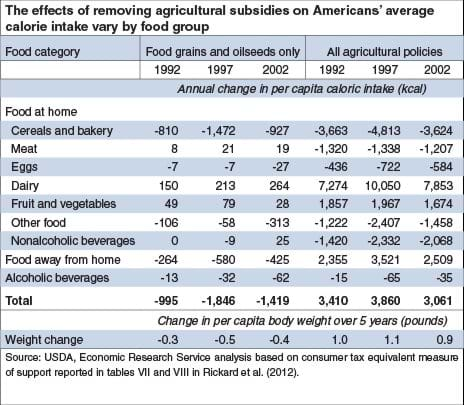Agricultural Policies Have Little Effect on U.S. Calorie Consumption
- by Abigail Okrent
- 12/3/2012
Many observers--including prominent economists, nutritionists, journalists, and elected officials--speculate that agricultural policies contribute to increased U.S. obesity rates by making certain farm commodities more abundant and therefore cheaper. They claim that farm program subsidies that lower prices for corn and wheat result in greater consumption of fattening foods and growing waistlines. However, a recent study by researchers at ERS, the University of California at Davis, and Cornell University finds that the effects of farm subsidies, when combined with the effects of other agricultural policies that restrict supply such as acreage set-asides or import barriers, have little impact on the amount of calories consumed by an average American adult.
The researchers used a model to simulate the effects on consumption of a hypothetical removal of all subsidies on food grains and oilseeds in 1992, 1997, and 2002. The model estimated changes in consumption of seven food groups, away-from-home foods, and alcoholic beverages. Results show that removal of subsidies would lead to a decrease in production of food grains and oilseeds and an increase in prices for these commodities. However, given how small a share agricultural commodities contribute to food costs, especially for more highly processed products, price increases for the various food groups would be minimal. Consequently, calorie consumption would decrease minimally as well--roughly between 1,000 and 1,800 calories per capita annually, or somewhere between a third and a half pound in body weight for an adult of average weight over a 5-year period. Cereals and bakery products and food away from home would see the largest decreases in calorie consumption, while the dairy and fruit and vegetables groups would see the largest increases.
Researchers also estimated changes in food consumption in the three time periods in response to removing all U.S. farm program subsidies, including subsidies for fish and aquaculture, and indirect subsidies provided by trade barriers that apply to U.S. imports of fruit, vegetables, sugar, and dairy products. Model results show that removing all agricultural subsidies would result in decreases in consumption of six of the nine food categories, but these declines were not enough to offset increases in consumption of dairy products, fruit and vegetables, and food away from home. Thus, with all subsidies removed, total caloric intake would increase between 3,100 and 3,900 calories per capita annually, or about 1 pound in body weight over a 5-year period.

This article is drawn from:
- 'How Have Agricultural Policies Influenced Caloric Consumption in the United States?'. (2012). Health Economics. DOI: 10.1002/hec.2799..


